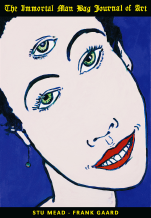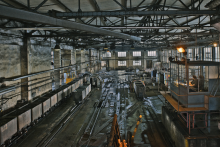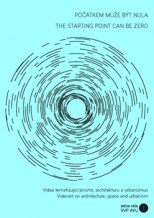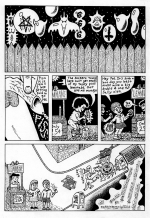| Umělec magazine 2000/4 >> Enter Multimediale | List of all editions. | ||||||||||||
|
|||||||||||||
Enter MultimedialeUmělec magazine 2000/401.04.2000 Michaela Freeman-Vlková | media | en cs |
|||||||||||||
|
The festival Enter Multimediale was the first attempt at putting on a large exhibition of new media in the Czech Republic. Only the Vilém Flusser Conference at the Goethe Institute, a Hi-Tech exhibition in Brno, and Orbis Fictus in the Waldstein Riding Hall preceded it. Enter presented a number of Czech and foreign artists over four days at several different locations in Prague. The presentation, however, was a bit chaotic, accidental and non-critical.
The exhibition on the Romanesque Floor of the Vladislav Hall at the Prague Castle repeatedly showed the installation Resident by Silver (first shown at Orbis Fictus in 1997) and a printed visualization of the computer project E-EREA by Federico Díaz (The Stone Bell House, January 2000). Ivan Chabanaud’s virtual reality entitled Icarus offered flight in a slightly clichéd abstract space. Milan Cais, who graduated from the Fine Arts Academy of Prague last year, bared himself in his autobiographical computer project complete with a sculpture on which faces were projected (clearly a la Tony Oursler). The Mirror by Pavel Smetana—incidentally, the festival’s program director—reflected distorted image and words. The concept of mirrors consisted of repetition and illusions, while a distorted mirror shattered the illusion, creating a kind of existence in a new space. An ASCII code creature in Head AI by Guillaume Stagnaro openly stated its own imperfection and foreseeability. It’s supposed to personify artificial intelligence as if we still need to perceive the physical appearance of robots—a tendency occurring in most fantasies about artificially created beings (and extraterrestrials). A video installation by Tamás Waliczky didn’t go beyond experimentation and adoration with the possibilities of computer visualization. The Fisherman and His Wife was a shadow play based on the well-known fairy tale. The Way was linked to the story of everlasting progress, and the third animation, Landscape, consisted of several video sequences based on 3-D effects. The eye of the viewer rotated around an axis with the resulting effect being the imitation of the possibility of stopping time and moving in space at T-0. Douglas E. Stanley’s installation Asymptote, was more successful. Viewers pulled on hanging strings, which caused three jointly connected video projections to move from screen to screen. Several short stories, or, rather, pieces of them, made their way across the screens and the resulting combination of motifs had the feel of non-linear dreams. The program of projections at the French Institute (with contributions from Hull Time Based Arts, Blackchair Productions of Seattle and 235 Media) looked very promising but was revised several times. Instead of the anticipated Japanese video art, I ended up watching videos of the French group that had disappointed the audience at their previous night’s performance. The CD-ROM exhibition at Archa Theater (Stelarc, Anna Hegedus, George Legrady, and others) ended unexpectedly one day before schedule. Much praise for the French musical robot performance at Vítkov Memorial. I appreciated this event not for the event itself but for the chance to visit this wonderful, monumental, though a bit morbid, thus far unused space. Most of this year’s Enter Multimediale content and organization did not live up to the professionalism of its financial backing and vast publicity. If this was the pilot program for a new annual festival, let’s hope that the sponsors will continue their support and that the program will get a significant boost. http://www.avu.cz/~vivid Translated by Vladan Šír.
01.04.2000
Recommended articles
|
|||||||||||||
|
04.02.2020 10:17
Letošní 50. ročník Art Basel přilákal celkem 93 000 návštěvníků a sběratelů z 80 zemí světa. 290 prémiových galerií představilo umělecká díla od počátku 20. století až po současnost. Hlavní sektor přehlídky, tradičně v prvním patře výstavního prostoru, představil 232 předních galerií z celého světa nabízející umění nejvyšší kvality. Veletrh ukázal vzestupný trend prodeje prostřednictvím galerií jak soukromým sbírkám, tak i institucím. Kromě hlavního veletrhu stály za návštěvu i ty přidružené: Volta, Liste a Photo Basel, k tomu doprovodné programy a výstavy v místních institucích, které kvalitou daleko přesahují hranice města tj. Kunsthalle Basel, Kunstmuseum, Tinguely muzeum nebo Fondation Beyeler.
|


































 New book by I.M.Jirous in English at our online bookshop.
New book by I.M.Jirous in English at our online bookshop.
Comments
There are currently no comments.Add new comment